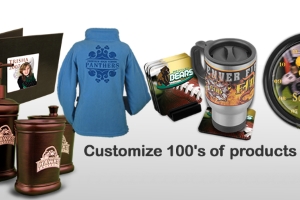Digital Printing (Web-to-print) — Outsourcing Essentials
Web-to-Print: Three reasons why the Web comes first
The quantity and loyalty of today’s printing company customers is intrinsically tied to the way the company’s web presence is organized. Over the last few years, companies and customers across a wide range of industries have grown accustomed to paying online for everything from mobile communication to medical consultation — and, since online payments save time and effort, companies are increasingly favoring eCommerce systems over traditional store-based platforms. Thus, it stands to reason that a print shop customer would expect to receive the same safe, convenient online tools for creating, ordering and purchasing printed materials.
The way in which small and mid-sized businesses search for suppliers has also changed. Previously, vendors were found via catalogues, and referrals were crucial. However, in today’s world, having a “first page” position in the search engine results is most important. This means that a print shop’s website and web applications must be developed with clear code and a customer-friendly interface and navigation.
Growing a printing business in today’s world also requires automation, so that the business can be as omnipresent as possible. The core business processes of every leading international printer are automated, from order placement to shipping. Automation has become essential for large printers due to 1) a global customer base, 2) huge order volumes and 3) sophisticated logistics.
So how can an up-and-coming digital printer meet these new challenges? And how can collaborating with an IT outsourcing partner simplify the solution?
Clients’ UI: Exciting ordering experience
The client-oriented features of any web-to-print system are intended to provide the client with an exciting and convenient ordering experience. Sure, some companies might offer a different number of these features, and differing levels of complexity, but ideally the core features’ primary function is to allow the customer to navigate the system as quickly as possible. Any additional features outside of the core group should be considered a bonus.
There are two big reasons why it’s a great idea to collaborate with an IT outsourcer when creating a web-to-print system. Firstly, it’s very likely that an outsourcer has experience in developing web-to-print systems; in fact, the outsourcer may already possesses ready-made modules which can be customized to your business and launched quickly. Secondly, in cases of iterative development, you won’t have to worry about staff-related overhead. You only pay for the time the outsourcing team works — not for downtime, or time spent measuring your modules’ efficiency periods.
And speaking of modules, the core modules of any solid web-to-print system are as follows:
- Storefront: This is where a customer chooses an item (business card, photo book, booklet, T-shirt, blanket, magazine, etc.), along with the item’s material type, size and color
- File uploader: For further order processing and printing, the customer uploads all the image files he wants placed on the item
- Online Editor: Using an online editor with different tools, filters and effects, the customer creates his own graphical product. An online library of templates and images is made available to simplify the process. If necessary, a batch of identical sample products with different texts can be created so the customer can see how a certain product might look
- 3D model: The customer views a 3D model of his created product in an interior, i.e. a blanket covering a bed, or modular art on a wall
- Internal Mail and Live Chat: At any moment, the customer must be able to contact the printer for help via internal mail or instant messenger
- Cart: This holds the customer’s chosen products and leads directly to the “order placement” stage
- Payment system: The customer pays for his order via an online payment system. Systems can be customized to suit a company’s exact needs
- User account: The user tracks his order status — order taken, order processed, order printed, order awaiting shipping, order shipped and order delivered. The system retains the customer’s order history and all of his created designs
- Feedback system: Through the feedback system, a customer provides his thoughts regarding product and service quality
- Social network integration: The customer can post his finished product to his social network profile, blog or website, or share it with friends/business associates via a web-to-print system. In the latter case, a collaboration tool is made available whereby a group of users could simultaneously make changes to the item
The end-result is a happy client who’s been converted from a website visitor to a customer, thanks to a classy web-to-print functionality. Now, what can we do to ensure he becomes a repeat customer?
Mobile and desktop: always on-hand
Customers could potentially use a custom printing service on a monthly basis, i.e. sales representatives who order promotional items, and individuals who order gifts for others, or items for personal use.
In order to become the go-to supplier for these types of customers, your web-to-print system should always be readily available to the customer, accessible in one click and thereby much faster and easier to use than your competitors. To reach this goal, a desktop and/or mobile app is a great solution. Once the customer downloads your app, your services will always be just a click away on their device, thus meeting today’s dominant tendency for resource-saving and internet connection independence. And by contracting with an IT outsourcing company that employs specialists covering a wide range of different platforms, you can be assured that any application can be efficiently developed for any platform.
Back-end features: business automation
From a printer’s point of view, a web-to-print system is mostly about full business automation intended to minimize human intervention across the process chain, from ordering to production to delivery.
The back-end portion of your web-to-print system could be developed module-by-module, and be as feature-rich as you desire:
- Storefront management system: Products list, prices, quantities, discounting, shipping costs editing, etc.
- Customer database: contacts, order history
- Financial subsystem: invoices, payment registration, A/R and A/P tracking, report generation
- Order status tracking
- Unloading orders in a print-ready format for your automated prepress process
- Warehouse management system: real-time inventory, as well as statistics, order lists and document preparation
- Integration with your existing website, touchscreen-enabled POS systems, MIS, ERP systems, online payment and shipping systems — even your own printers!
- Advertising module for measuring traffic and tracking visitors
- Partnership contractual relations monitoring
The more processes you automate, the shorter your order completion time and the higher your cost-efficiency will be. Through step-by-step automation, a little print shop can become a huge multinational custom printing enterprise — and Sibers has the clients to prove it!
Sibers’ Experience in Digital Printing
Sibers has worked with the printing industry since 2005. Our team has an acute understanding of digital printers’ wants and needs, and we’ve developed a variety of custom printing websites as well as online, desktop and mobile editors for photo book creation, custom apparel and favors, order processing systems, bookkeeping and financial systems, order status tracking, warehouse management tools and internal instant messages.
Once upon a time, a young American launched a tiny print shop where people could order custom-printed apparel. In the beginning, the shop had a couple of customers per day, and orders came in via fax, sometimes hand-drawn on paper. Fast-forward a few years, and this tiny print shop is now a huge international custom printing enterprise that processes more than 1,000 orders per day. The question is, what happened during those few years?
Since this is a true story whose protagonist happens to be our client, we already know the two answers: experience and automation. Of course, printing competency is the core necessity of any print enterprise, and must be the foundation for future success. But sitting in second place is automation, and when speaking about business expansion and cost optimization, it’s the most essential tool.
To learn more about Sibers’ experience with developing winning platform solutions for the printing industry, please view our Case Studies.
Featured case studies developed for Digital printing industry
Need a development team for your -to-print business?
Request a quoteWhitepapers
- Building MVP for Startups
- Architecture: Why Does it Matter?
- Functionality vs. Classy: The “90/90 Percent” App Rule
- The Essentials of Custom Development for Printing Businesses
- IT Projects: It Takes Two To Meet A Deadline
- E-Learning Evolution: Custom E-Learning Development Trends
- Getting iOS App Crash Logs
- You Asked, We Answered: Testing, Debugging, and What on Earth Does “Best Practices” Really Mean?
- The Limits of Perfection: Where Pixel-perfectionists Need to Stop and Think
- Software cost estimation: What factors are key in IT project estimates?
- Why go outsource?
- DIY: When Does It Make Sense?



